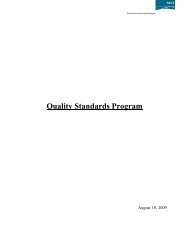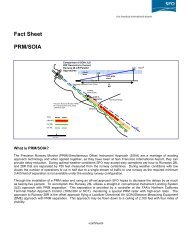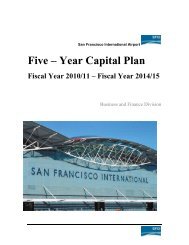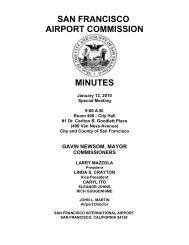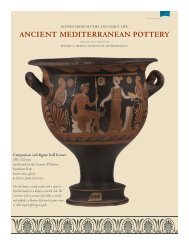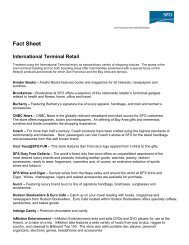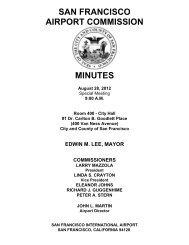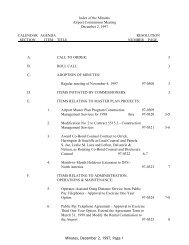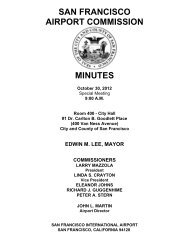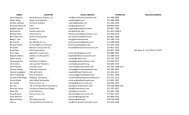Official Statement Airport Commission City and County of San ...
Official Statement Airport Commission City and County of San ...
Official Statement Airport Commission City and County of San ...
Create successful ePaper yourself
Turn your PDF publications into a flip-book with our unique Google optimized e-Paper software.
the beneficiaries (the people <strong>of</strong> the State). Under the law, any such amendment or revocation could not impair the<br />
accomplishment <strong>of</strong> trust purposes, or abrogate the existing covenants <strong>and</strong> agreements between the <strong>City</strong>, acting by<br />
<strong>and</strong> through the <strong>Commission</strong>, as trustee, <strong>and</strong> the <strong>Airport</strong>’s bondholders. The <strong>Commission</strong> does not anticipate that<br />
the State will revoke the tidel<strong>and</strong>s grants.<br />
State Proposition 218<br />
In November 1996, the voters <strong>of</strong> the State approved Proposition 218, known as the “Right to Vote on Taxes<br />
Act.” Proposition 218 adds Articles XIII C <strong>and</strong> XIII D to the California Constitution, <strong>and</strong> contains a variety <strong>of</strong><br />
interrelated provisions concerning the ability <strong>of</strong> local governments, including the <strong>City</strong>, to impose both existing <strong>and</strong><br />
future taxes, assessments, fees <strong>and</strong> charges.<br />
Article XIII C removes limitations on the initiative power in matters <strong>of</strong> local taxes, assessments, fees <strong>and</strong><br />
charges. Consequently, the voters <strong>of</strong> the <strong>City</strong> could, by future initiative, seek to repeal, reduce, or prohibit the future<br />
imposition or increase <strong>of</strong>, any local tax, assessment, fee or charge. “Assessment,” “fee,” <strong>and</strong> “charge” are not<br />
defined in Article XIII C <strong>and</strong> it is unclear whether the definitions <strong>of</strong> such terms contained in Article XIII D<br />
(which are generally property-related as described below) are so limited under Article XIII C.<br />
Article XIII D conditions the imposition <strong>of</strong> a new or increased “fee” or “charge” on either voter approval or<br />
the absence <strong>of</strong> a majority protest, depending upon the nature <strong>of</strong> the fee or charge. The terms “fee” <strong>and</strong> “charge” are<br />
defined to mean levies (other than ad valorem taxes, special taxes <strong>and</strong> assessments) imposed by a local government<br />
upon a parcel or upon a person as an incident <strong>of</strong> the ownership or tenancy <strong>of</strong> real property, including a user fee or<br />
charge for a “property-related service.” No assurance can be given that the voters <strong>of</strong> the <strong>City</strong> will not, in the future,<br />
approve initiatives which seek to repeal, reduce, or prohibit the future imposition or increase <strong>of</strong>, assessments, fees,<br />
or charges, including the <strong>Commission</strong>’s fees <strong>and</strong> charges, which are the source <strong>of</strong> Net Revenues pledged to the<br />
payment <strong>of</strong> debt service on the Bonds. The <strong>Commission</strong> believes that Article XIII D does not apply to <strong>Airport</strong> fees<br />
<strong>and</strong> charges imposed by the <strong>Commission</strong>.<br />
The interpretation <strong>and</strong> application <strong>of</strong> the Proposition 218 will ultimately be determined by the courts or<br />
through implementing legislation. The <strong>Commission</strong> is unable to predict the outcome <strong>of</strong> any such litigation or<br />
legislation.<br />
Noise Mitigation <strong>and</strong> Variance<br />
General<br />
In accordance with State regulations administered by the California Department <strong>of</strong> Transportation<br />
(“Title 21”), each California airport which has a noise impact area defined by the 65 decibel (Db) Community Noise<br />
Equivalent Level (“CNEL”) contour is required to apply for a variance from those regulations. As <strong>of</strong> October 2002,<br />
the <strong>Airport</strong> became the first major commercial airport in the State to achieve Title 21 compliance <strong>and</strong> therefore is<br />
permitted to operate without a variance. In order to maintain compliance with Title 21 regulations, the <strong>Airport</strong><br />
continues to monitor aircraft noise levels through the preparation <strong>of</strong> quarterly 65 Db CNEL contour maps <strong>and</strong> <strong>of</strong>fers<br />
insulation to new property owners at sites where previous owners declined participation in the noise insulation<br />
program.<br />
The significant progress made by the <strong>Commission</strong> in reducing the impact <strong>of</strong> aircraft noise on the<br />
communities surrounding the <strong>Airport</strong> resulted from the implementation <strong>of</strong> (1) noise abatement flight procedures,<br />
(2) an aircraft noise insulation program, (3) community outreach through the <strong>Airport</strong> Community Roundtable, <strong>and</strong><br />
(4) requests that certain surrounding communities adopt ordinances to protect new purchasers <strong>of</strong> homes within their<br />
community.<br />
Noise Abatement Procedures<br />
The <strong>Commission</strong> has instituted a wide range <strong>of</strong> noise abatement procedures to reduce the impact <strong>of</strong><br />
aircraft-generated noise on the neighboring communities surrounding the <strong>Airport</strong>. These procedures include “quiet<br />
bridge approach” <strong>and</strong> “preferential runway departure” policies, among others. The preferential runway departure<br />
62



